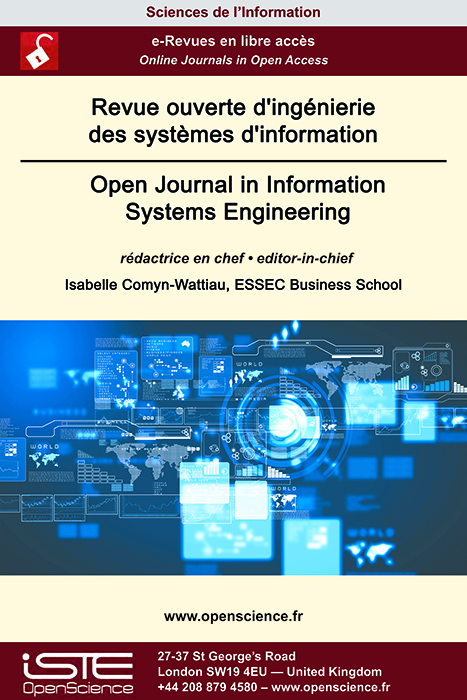

Information and Communication > Home > Open Journal in Information Systems Engineering > Issue
Ce numéro spécial de la revue Open SI regroupe quelques articles d’INFORSID’22 en version étendue. Ils ont été choisis d’une part pour leur qualité scientifique, mais aussi pour leur représentativité des sujets qui animent la communauté. Nous remercions les auteurs de leur contribution, tout comme les relecteurs de ces nouvelles versions. Si tous les articles sont orientés modèles et méthodes ils s’adressent cependant à des champs différents.
Data is a strategic asset for organizations. Assessing its value provides companies with a mean to identify strategies that offer a competitive advantage and to measure their informational capital. There is neither an approach nor a set of standards and rules to apply for this valuation due to the intangible nature of data. In this paper, we propose an approach combining an enriched concept of data value, a conceptual model including this concept and the notion of context, and a value assessment method based on this model. The originality is to combine risk-based approaches with the more classical approaches to the valuation of tangible assets (cost, market, or income approaches). The approach is confronted with several real cases from the literature allowing a validation of its usefulness and added value.
Sheet music scores have been the traditional way to preserve and disseminate Western classical music works for centuries. Nowadays, their content can be encoded in digital formats that yield a very detailed representation of music content expressed in the language of music notation. These encoded (digital) scores constitute an invaluable asset for digital library services such as search, analysis, clustering, and recommendations. In this paper, we propose a model of the musical content of digital score as graph data, which can be stored in a graph database management system. We then discuss the querying of such data through graph pattern queries. We also describe a proof-of-concept of the approach that allows uploading music scores in a Neo4j database, and expressing searches and analyses through graph pattern queries with the query language Cypher.
The objective of the article is to show the co-design of daily mobility services for seniors in rural and peri-urban areas through a continuous improvement method enriched with fragments of methods (Design Thinking, scenario-by-design, innovation by usages) in order to take into account the complexity of mobility services required by end-users (permanent changes, immediacy, specific constraints). Creating services on the fly is not easily compatible with design methods for socio-technical ecosystems which require fairly stable procedures. In this article, we present the reference framework (As-Is/As-If), the ecosystem study phases (analysis, diagnosis and innovation), the augmentation of the method by adding other methods fragments and a summary of the proposed service innovations. We also present the experiments carried out and the serious game created to facilitate the co-construction of mobility services.
This paper is part of the DA3T project in collaboration with geographers. The objective is to propose methods and tools to process mobility tracks in order to improve their analysis and consequently touristic territory planning and valorization. As part of the design of a module for computing similarity for computing similarity between two semantic trajectories, we present two new similarity measures addressing all three dimensions (i.e. spatial, temporal and thematic).
This paper represents a collection of three best articles from the Forum des Jeunes Chercheuses Jeunes Chercheurs (JCJC) – Young Researchers – of the INFORSID 2022 conference. These contributions include the modeling that has been selected as the central topic of this invited paper. The works of the French Young Researchers focus on the use of conceptual modeling for various topics such as construction of contextual process models, modeling of chemodiversity, and educational games in classrooms. In this article, the Young Researchers explain the context of their research, present the corresponding conceptual model, explain the use of the model and the research perspectives.

2025
Volume 25- 5
Issue 12024
Volume 24- 4
Special Issue2023
Volume 23- 3
Special issue2021
Volume 21- 2
Issue 12020
Volume 20- 1
Issue 1